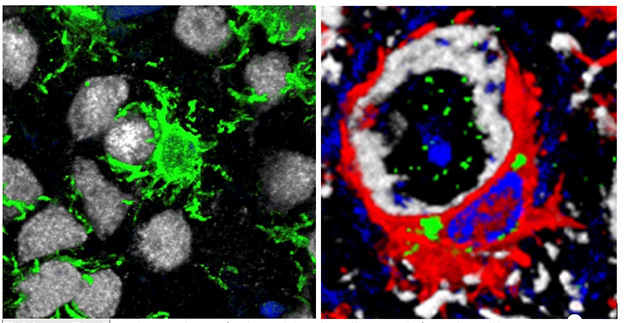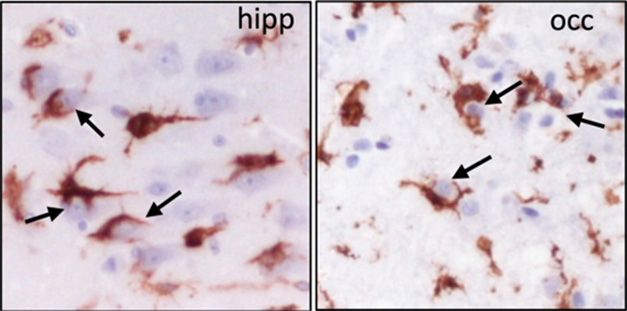Do Overloaded Microglia Smother Stressed Neurons?
Quick Links
In neurodegenerative diseases, microglia can help or harm the brain. In the October 3 Journal of Clinical Investigation, scientists led by Ilia Baskakov at the University of Maryland School of Medicine, Baltimore, documented a transition from the former mode to the latter. In mice infected with prion disease, microglia initially scarfed up misfolded prion protein. As they became stuffed with indigestible aggregates, however, their behavior changed. Microglia sidled up to neurons, wrapping their processes around these cells to partially engulf them. The covered neurons did not die, but struggled to function, with many synaptic genes suppressed. At the same time, prion replication took off, and the mice showed the first signs of disease, losing their fear of open spaces.
- In mice with symptomatic prion disease, microglia partially envelop many neurons.
- This correlates with worsening infection, beginning two weeks before symptoms.
- Neuron engulfment may mark a shift from helpful to harmful microglia.
The clinical worsening after microglia envelop neurons suggests the phenomenon is harmful, the authors noted. “With disease progression, microglial behavior changes from positive to negative,” Baskakov told Alzforum. He plans to investigate if preventing this could slow deterioration.
That would be important to know, because the same thing happens in human brain. In postmortem sections from cortical and subcortical brain regions of 57 people with sporadic Creutzfeldt-Jakob disease, the authors found many microglia enveloping neurons. Baskakov believes the finding might apply to other neurodegenerative diseases, as well.

Taking a Bite? In the cortices of mice with prion disease (left), microglia (green) surround neurons (gray). A three-dimensional reconstruction of confocal microscopy images (right) shows prion aggregates (green) in both microglia (red) and enveloped neurons (surface is white). Nuclei are blue. [Courtesy of Makarava et al., 2024.]
Some previous work had suggested that microglia could worsen neurodegenerative disease by chowing down on healthy neurons (for review see Butler et al., 2021). This has been observed in cell culture, where microglia attack tangle-bearing neurons, but not directly in brain (Aug 2018 news; Oct 2021 news).
To find out if it happens in vivo, Baskakov and colleagues infected mice with an aggressive prion known as synthetic strain leading to overweight (SSLOW), which kills mice within four months. The authors previously generated this strain by denaturing recombinant hamster prion protein, injecting it into the brains of wild-type hamsters, then isolating aggregates from those animals and injecting them into healthy ones (Makarava et al., 2010; Jeffrey et al., 2013).
In the cortices of SSLOW-infected, symptomatic mice, first author Natallia Makarava found that microglia had partially encircled up to a third of neurons. Instead of merely extending pseudopodia, as microglia typically do when they eat things, their cell bodies snuggled up to the cells and their processes wrapped the neurons in a bear hug (image above). Very rarely—about 1 percent of the time—microglia fully engulfed the cells. The same partial engulfment occurred in other brain regions, including the hippocampus, striatum, and thalamus. In healthy uninfected mice, by contrast, microglia kept their hands to themselves.

Shout for Help? In control mice (top), healthy neurons express abundant GRIN1 (red) on their surface, and microglia (green) keep their distance. In prion-infected mice (bottom), GRIN1 expression falls, and microglia snuggle up. [Courtesy of Makarava et al., 2024.]
Examining SSLOW mice at different stages of infection, Makarava and colleagues found that microglia began wrapping up neurons about two weeks before symptoms appeared. This worsened as disease progressed, with almost two-thirds of neurons being surrounded by end-stage disease. In three other models that used less aggressive prion strains, microglia did the same thing, but surrounded fewer neurons. To the authors, this suggested that envelopment correlates with disease stage and severity.
Why does it happen? Possibly, malfunctioning neurons provoke the microglial response. The expression of neuronal genes involved in synaptic transmission, learning, and memory dropped by up to half as disease progressed. In particular, the NMDA receptor subunit GRIN1 dwindled about two weeks before microglia made their move. Perhaps the change signals microglia to finish off struggling cells, the authors suggested (image at left). However, unlike the microglial eating of synapses in neurodegenerative disease, the innate immune complement pathway was not involved in this signaling, the authors found.
In line with the idea that microglia were heading in for the kill, microglia revved up their lysosomal activity as they approached neurons, implying they were preparing for a big meal. Nonetheless, once prion-stuffed microglia contacted a neuron, they seemed to stall out. They did not take up much neuronal material, nor did they kill neurons. Having gorged on misfolded prions, the cells may not be able to consume any more, Baskakov suggested. He noted that an overload of aggregated protein can damage lysosomes. In another sign of this, enveloping microglia began to express apoptotic markers, hinting that they were becoming senescent.

Human Brain, Too. In sections from the hippocampi (left) and occipital cortices (right) of people who died of sporadic CJD, microglia (brown) encircle many neurons (blue, arrows). [Courtesy of Makarava et al., 2024.]
Christina Ising at University Hospital of Cologne, Germany, noted that work from her lab and others has shown that chowing down on tangles can push microglia into senescence (Brelstaff et al., 2021; Karabag et al., 2023). “If these microglia are senescent, it would be very interesting to investigate how prion diseases progress under senolytic treatments at different time points after infection,” she suggested (comment below).
Overall, the data fit a picture where microglia initially help slow disease by mopping up misfolded prions, but eventually sicken and turn harmful, Baskakov said. Prior animal studies support this, showing that microglia improve survival at early stages of prion disease (Zhu et al., 2016; Carroll et al., 2018; Bradford et al., 2022). At later stages, however, eliminating microglia can lengthen lifespan (Gómez-Nicola et al., 2013; Nazmi et al., 2019; Nakagaki et al., 2020).
Next, Baskakov will study the mechanisms underlying this microglia-neuron interaction. He noted that unlike mouse models of Alzheimer’s and similar neurodegenerative diseases, prion-infected mice have the actual disease, suggesting the findings will more directly translate to people.—Madolyn Bowman Rogers
References
News Citations
- Tangles Turn Neuronal Membranes Inside Out, Give Microglia License to Eat Their Fill
- After Eating Tangle-Tainted Neurons, Microglia Spew Tau, Lose Appetite
Paper Citations
- Butler CA, Popescu AS, Kitchener EJ, Allendorf DH, Puigdellívol M, Brown GC. Microglial phagocytosis of neurons in neurodegeneration, and its regulation. J Neurochem. 2021 Aug;158(3):621-639. Epub 2021 Mar 17 PubMed.
- Makarava N, Kovacs GG, Bocharova O, Savtchenko R, Alexeeva I, Budka H, Rohwer RG, Baskakov IV. Recombinant prion protein induces a new transmissible prion disease in wild-type animals. Acta Neuropathol. 2010 Feb;119(2):177-87. Epub 2010 Jan 6 PubMed.
- Jeffrey M, McGovern G, Makarava N, González L, Kim JS, Rohwer RG, Baskakov IV. Pathology of SSLOW, a transmissible and fatal synthetic prion protein disorder and comparison with naturally occurring classical Transmissible Spongiform Encephalopathies. Neuropathol Appl Neurobiol. 2013 Apr 12; PubMed.
- Brelstaff JH, Mason M, Katsinelos T, McEwan WA, Ghetti B, Tolkovsky AM, Spillantini MG. Microglia become hypofunctional and release metalloproteases and tau seeds when phagocytosing live neurons with P301S tau aggregates. Sci Adv. 2021 Oct 22;7(43):eabg4980. Epub 2021 Oct 20 PubMed.
- Karabag D, Scheiblich H, Griep A, Santarelli F, Schwartz S, Heneka MT, Ising C. Characterizing microglial senescence: Tau as a key player. J Neurochem. 2023 Aug;166(3):517-533. Epub 2023 Jun 5 PubMed.
- Zhu C, Herrmann US, Falsig J, Abakumova I, Nuvolone M, Schwarz P, Frauenknecht K, Rushing EJ, Aguzzi A. A neuroprotective role for microglia in prion diseases. J Exp Med. 2016 May 30;213(6):1047-59. Epub 2016 May 16 PubMed.
- Carroll JA, Race B, Williams K, Striebel J, Chesebro B. Microglia Are Critical in Host Defense Against Prion Disease. J Virol. 2018 May 16; PubMed.
- Bradford BM, McGuire LI, Hume DA, Pridans C, Mabbott NA. Microglia deficiency accelerates prion disease but does not enhance prion accumulation in the brain. Glia. 2022 Nov;70(11):2169-2187. Epub 2022 Jul 19 PubMed.
- Gómez-Nicola D, Fransen NL, Suzzi S, Perry VH. Regulation of microglial proliferation during chronic neurodegeneration. J Neurosci. 2013 Feb 6;33(6):2481-93. PubMed.
- Nazmi A, Field RH, Griffin EW, Haugh O, Hennessy E, Cox D, Reis R, Tortorelli L, Murray CL, Lopez-Rodriguez AB, Jin L, Lavelle EC, Dunne A, Cunningham C. Chronic neurodegeneration induces type I interferon synthesis via STING, shaping microglial phenotype and accelerating disease progression. Glia. 2019 Jul;67(7):1254-1276. Epub 2019 Jan 25 PubMed.
- Nakagaki T, Ishibashi D, Mori T, Miyazaki Y, Takatsuki H, Tange H, Taguchi Y, Satoh K, Atarashi R, Nishida N. Administration of FK506 from Late Stage of Disease Prolongs Survival of Human Prion-Inoculated Mice. Neurotherapeutics. 2020 Jun 1; PubMed.
Further Reading
Primary Papers
- Makarava N, Safadi T, Bocharova O, Mychko O, Pandit NP, Molesworth K, Baiardi S, Zhang L, Parchi P, Baskakov IV. Reactive microglia partially envelop viable neurons in prion diseases. J Clin Invest. 2024 Oct 3; PubMed.
Annotate
To make an annotation you must Login or Register.

Comments
No Available Comments
Make a Comment
To make a comment you must login or register.